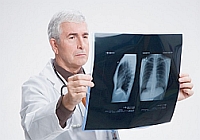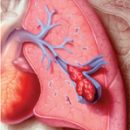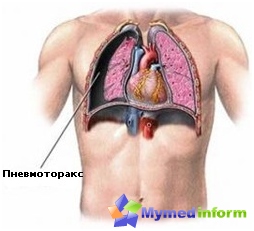Familiarize yourself with the main signs of a cunning cold - pneumonia. Learn about her pathogens and basic symptoms characteristic of pneumonia in adults.
Content
 Infectious disease pneumonia — Very common and sufficiently studied, but there are cases when it is very difficult to recognize and correctly differentiate, assigning timely therapy. Such cases in 90% ended with a fatal outcome. To better learn this is not a simple and insidious disease, get acquainted with him closer, considering signs of pneumonia in adults.
Infectious disease pneumonia — Very common and sufficiently studied, but there are cases when it is very difficult to recognize and correctly differentiate, assigning timely therapy. Such cases in 90% ended with a fatal outcome. To better learn this is not a simple and insidious disease, get acquainted with him closer, considering signs of pneumonia in adults.
In the lower airways contain a large number of pathogenic bacteria, which, when a person is healthy, do not show themselves. But it is worthwhile to change the external and internal conditions, as a favorable environment is created for the growth of these pathogenic microbes, which leads to the development of pneumonia. With pneumonia there is inflammation of the pulmonary fabric, which provokes such factors as:
- infections, viruses preceding colds, atypical bacteria (mycoplasma, chlamydia, legionella);
- damage to the respiratory system by various chemicals (poisonous poisonous gases, pairs);
- Radiation impact on respiratory organs to which any infection is easily joined;
- various kinds of allergic reactions acting on the lungs;
- Thermal impact: burns or supercooling of respiratory organs;
- frequent stress and depression.
We consider the type of pneumonia, which is called community-friendly or non-populated, that is, the not as a complication of long-staying on IVL or the current disease, with which the patient is in the hospital. Most often, the reasons for such pneumonia can be:
- streptococcus — Pathogenic bacterium, the most frequent and dangerous pathogen, the mortality rate is quite high;
- Pneumococcus — causes a bruboral pneumonia;
- Mycoplasma (intracellular causative agent) — It belongs to 31%, mostly young people and children are sick;
- Chlamydia causes pneumonia in people of young and middle age (intracellular virus);
- Legionella (intracellular virus) — very rare, but dangerous causative agent — the likelihood of a deadly outcome is great; usually «Helps» sick conditioner;
- Hemophilic stick — pathogenic bacterium, frequent guest in patients with chronic diseases of the organs of the lower respiratory tract and avid smokers;
- enterobacteria can cause pneumonia in people with the problems of heart, liver, kidney, as well as diabetes;
- Staphilococcus — The pathogenic type of bacteria, most often provokes pneumonia in the elderly and those who have suffered flu;
- Herpes, Flu Virus, Paragrippa, Mushrooms — less often are among the causative agents of pneumonia.
Where does pneumonia begin in adults
The inflammation of the lungs is not an independent disease that begins immediately and diagnosed from the first day of the disease. It can be assumed as a complication after a cold: ARVI, flu and other things. You can suspect inflammation of the lower respiratory tract (bronchi, light), if the cold does not pass seven days, especially if the patient's condition deteriorates sharply. Temperature can vary from 37.2 to 40°WITH. When antipyretic do not give effect, you can assume the beginning of pneumonia in adults.
Typical disease symptoms include:
- cough — Initially, dry and permanent, as inflammation spread — wet, with an admixture of pus in sputum, sometimes greenish color with an unpleasant smell;
- chest pain — Feels especially in the breath, deep breath is very painful, there is a shortage of air;
- cough after the breath — testifies to the inflammation of the lungs;
- shortness of breath at rest (if the site of the defeat is large enough, then it reaches twenty inhales per minute);
- Signs of intoxication: pale skin, weakness, sweating (more often at night), chills, deterioration of appetite;
- The temperature rises for three days;
- intense headache;
- nausea, vomiting appears less.
 Symptoms may appear during a conventional cold or after the improvement period, which indicates signs of pneumonia.
Symptoms may appear during a conventional cold or after the improvement period, which indicates signs of pneumonia.
Signs can be more pronounced — have bright and clear symptoms — or weakly manifested: it all depends on the patient's immunity, the degree of inflammation, the pathogen, the method of entering the body and the presence of concomitant diseases. It happens that the diagnosis «pneumonia» It is difficult to put, as inflammation can be small or the focus is deep in the tissue of lung and wheezing may not be heard.
Atypical pneumonia caused by mycoplasma, the symptoms join burning in the throat and runny nose. «Air conditioning disease» — The inflammation caused by legionells is not manifested by a cough or a runny nose. Mountain pain, weakness and frequent liquid chair — Here are the main symptoms of inflammation of this pathogen. Brewing pneumonia demonstrates «Rusty» Wet and temperature up to 41°WITH.









